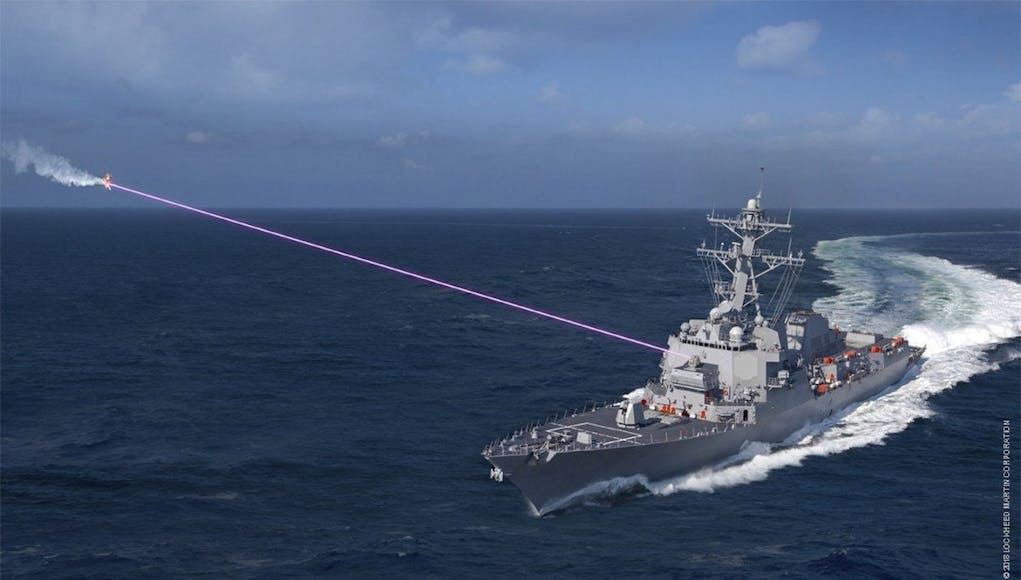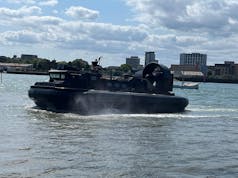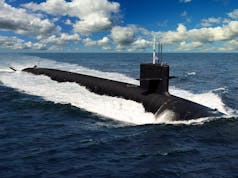The US Navy has awarded Lockheed Martin a $150 million contract, with options worth up to $942.8 million, for the development, manufacture and delivery of two high power laser weapon systems.
The deal includes intelligence, surveillance and reconnaissance and counter-Unmanned Aerial System capabilities, by fiscal year 2020 say Lockheed.
With the High Energy Laser and Integrated Optical-dazzler with Surveillance (HELIOS) system, Lockheed Martin says it will help the US Navy take a major step forward in its goal to field laser weapon systems aboard surface ships.
“The HELIOS program is the first of its kind, and brings together laser weapon, long-range ISR and counter-UAS capabilities, dramatically increasing the situational awareness and layered defense options available to the US Navy,” said Michele Evans, vice president and general manager of Integrated Warfare Systems and Sensors.
“This is a true system of capabilities, and we’re honoured the Navy trusted Lockheed Martin to be a part of fielding these robust systems to the fleet.”
HELIOS combines three key capabilities, brought together for the first time in one weapon system say Lockheed Martin who sent us the following information:
- A high-energy laser system: The high-energy fiber laser will be designed to counter unmanned aerial systems and small boats. The energy and thermal management system will leverage Lockheed Martin experience on Department of Defense programs, and the cooling system will be designed for maximum adaptability onboard ships. In addition, Lockheed Martin will bring decades of shipboard integration experience, reducing risk and increasing reliability.
- A long-range ISR capability: HELIOS sensors will be part of an integrated weapon system, designed to provide decision-makers with maximum access to information. HELIOS data will be available on the Lockheed Martin-led Aegis Combat System.
- A counter-UAS dazzler capability: The HELIOS dazzler will be designed to obscure adversarial UAS-based ISR capabilities.
In this first increment of the US Navy’s Surface Navy Laser Weapon System program, Lockheed Martin will deliver two units for test by 2020. One unit will be delivered for shipboard integration on an Arleigh Burke-class destroyer, and one unit will be used for land testing at White Sands Missile Range.
“Lockheed Martin’s spectral beam combined fiber lasers bring flexibility and adaptability to defensive and offensive missions,” said Dr. Rob Afzal, senior fellow of laser weapon systems. “Our design is scalable, and we can optimise it to meet requirements for future increments.”














Hope they hurry up with this. We will need it fitted to Typhoons to intercept Putins new maneuvrable MIRVs.
It will be interesting to see what the uk’s Dragonfire project will result with. A consortium including MBNA, Leonardo, Quinetic and Bae are involved.
Who will come up with best design? Might have been worth just going in with the US on R&D.
I’d be confident elsewhere within MoD the DSTL and the DARPA from the US DoD will have been doing plenty of work on these.
Agreed Tim, throw our lot in with the US. The combined research and production numbers involved would make it affordable to deploy across the RN/RFA fleet.
Again the testing regime ashore will not match the testing regime at sea.
White Sands is at 1200 m altitude, inland, in clear dry desert air.
An Arleigh Burke at sea obviously isn’t.
So whilst you may get great results in New Mexico the results at sea are going to be a lot different when you add in the effects of moisture laden air, pollution, surface haze and IR spectral windows at sea level.
No doubt the range will be somewhat less than perfect test range conditions.
You definitely need to mount them as high as possible on the mast.
1200m+?
Would that be 1200m+?
There are lots of more efficient ways to resist small boats and UAVs. We need laser systems that can shoot down highly manoeverable supersonic and hypersonic missiles. I wonder wherher that would be possible.
Lasers powered by nuclear reactors have been tested. We certainly need enough power to defeat missiles.
thank you so much madam